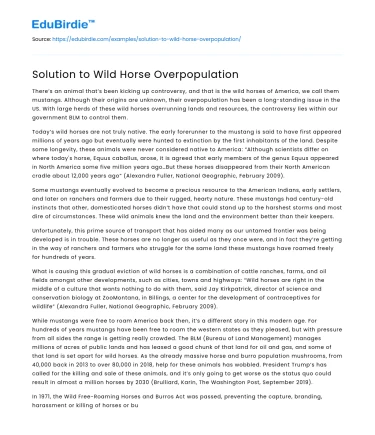There’s an animal that’s been kicking up controversy, and that is the wild horses of America, we call them mustangs. Although their origins are unknown, their overpopulation has been a long-standing issue in the US. With large herds of these wild horses overrunning lands and resources, the controversy lies within our government BLM to control them.
Today’s wild horses are not truly native. The early forerunner to the mustang is said to have first appeared millions of years ago but eventually were hunted to extinction by the first inhabitants of the land. Despite some longevity, these animals were never considered native to America: “Although scientists differ on where today's horse, Equus caballus, arose, it is agreed that early members of the genus Equus appeared in North America some five million years ago…But these horses disappeared from their North American cradle about 12,000 years ago” (Alexandra Fuller, National Geographic, February 2009).
Save your time!
We can take care of your essay
- Proper editing and formatting
- Free revision, title page, and bibliography
- Flexible prices and money-back guarantee
Some mustangs eventually evolved to become a precious resource to the American Indians, early settlers, and later on ranchers and farmers due to their rugged, hearty nature. These mustangs had century-old instincts that other, domesticated horses didn’t have that could stand up to the harshest storms and most dire of circumstances. These wild animals knew the land and the environment better than their keepers.
Unfortunately, this prime source of transport that has aided many as our untamed frontier was being developed is in trouble. These horses are no longer as useful as they once were, and in fact they’re getting in the way of ranchers and farmers who struggle for the same land these mustangs have roamed freely for hundreds of years.
What is causing this gradual eviction of wild horses is a combination of cattle ranches, farms, and oil fields amongst other developments, such as cities, towns and highways: “Wild horses are right in the middle of a culture that wants nothing to do with them, said Jay Kirkpatrick, director of science and conservation biology at ZooMontana, in Billings, a center for the development of contraceptives for wildlife” (Alexandra Fuller, National Geographic, February 2009).
While mustangs were free to roam America back then, it’s a different story in this modern age. For hundreds of years mustangs have been free to roam the western states as they pleased, but with pressure from all sides the range is getting really crowded. The BLM (Bureau of Land Management) manages millions of acres of public lands and has leased a good chunk of that land for oil and gas, and some of that land is set apart for wild horses. As the already massive horse and burro population mushrooms, from 40,000 back in 2013 to over 80,000 in 2018, help for these animals has wobbled. President Trump’s has called for the killing and sale of these animals, and it’s only going to get worse as the status quo could result in almost a million horses by 2030 (Brulliard, Karin, The Washington Post, September 2019).
In 1971, the Wild Free-Roaming Horses and Burros Act was passed, preventing the capture, branding, harassment or killing of horses or burros. This restricted the way that the BLM dealt with this enormous population to rounding them up and stuffing them in large holding corrals: “…the BLM, which is charged with managing most of the animals, periodically rounds up horses and now has nearly 50,000 in holding” (Karin Brulliard, The Washington Post, September 2019).
Using fertility control such as PZP, that is administered periodically by dart, killing where allowed by law, granting permission to the interior secretary to euthanize sickly, unadopted or older wild horses and burros, and adoption: annually, dozens of gathers remove thousands of wild horses off the range. Hundreds of horses were trucked to Canon City, Colorado to a prison to be branded, gelded and organized by gender and age. Some would be trained for auction later on, and others would be put up for adoption (Alexandra Fuller, National Geographic, February 2009).
And these solutions have managed to work to some degree throughout the past, but the problem still remains. If that wasn’t enough, the AML (Appropriate Management Level) for horses and burros is supposed to be about 27,000, whereas the current population of wild horses alone – as of March 1st, 2019 – is 71,892 (U.S. Department of the Interior, 2019).
Another, though controversial solution that some propose is to license slaughterhouses in order to help owners who can no longer afford to care for their animals. Back in 2007 the inspection of horse meat was obstructed by Congress which ended sales between states. But that doesn’t stop the sale of horse meat within the state which is legal (Coppins, Mckay, Newsweek, November 2010).
As you can see, there are many who would like these horses to be gone, and they all have good reasons for it. From economic standpoint, it would be entirely beneficial for these horses to just ‘disappear’. And while rounding up these poor horses seems to work for now with killing being a great secondary option, it is not only inhumane, it is also very expensive. The BLM keeps around 30,000 horses in permanent captivity, costing on average $2 for each horse per day (which amounts to $60,000 per day, which is around $22 million per year). Which soaks up most of the BLM’s budget, and only provides a temporary solution for a fast-breeding problem.






 Stuck on your essay?
Stuck on your essay?

